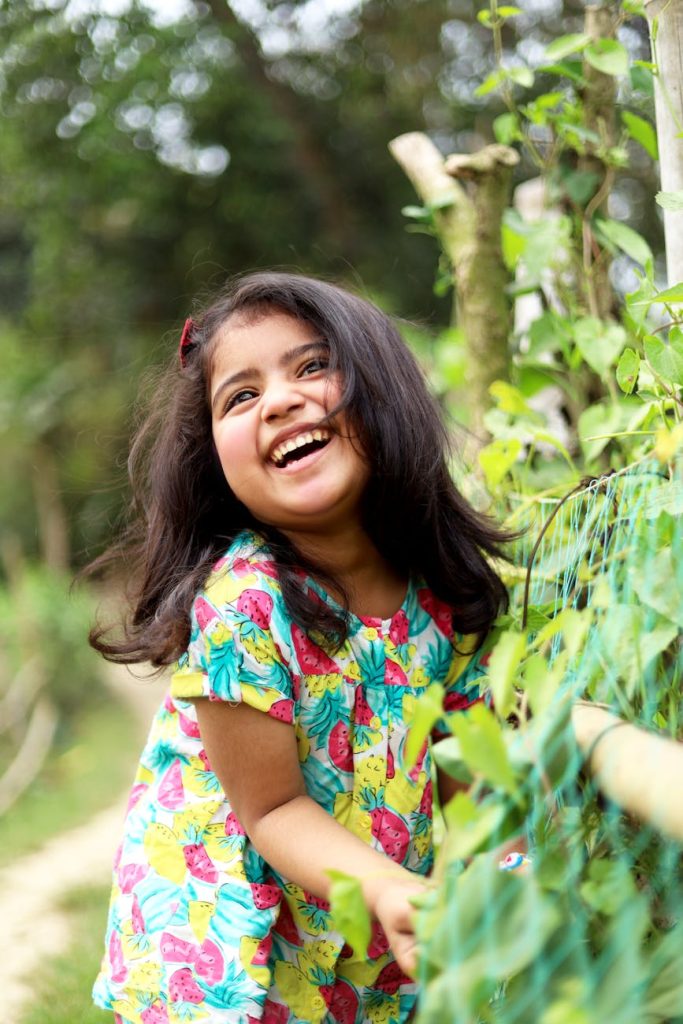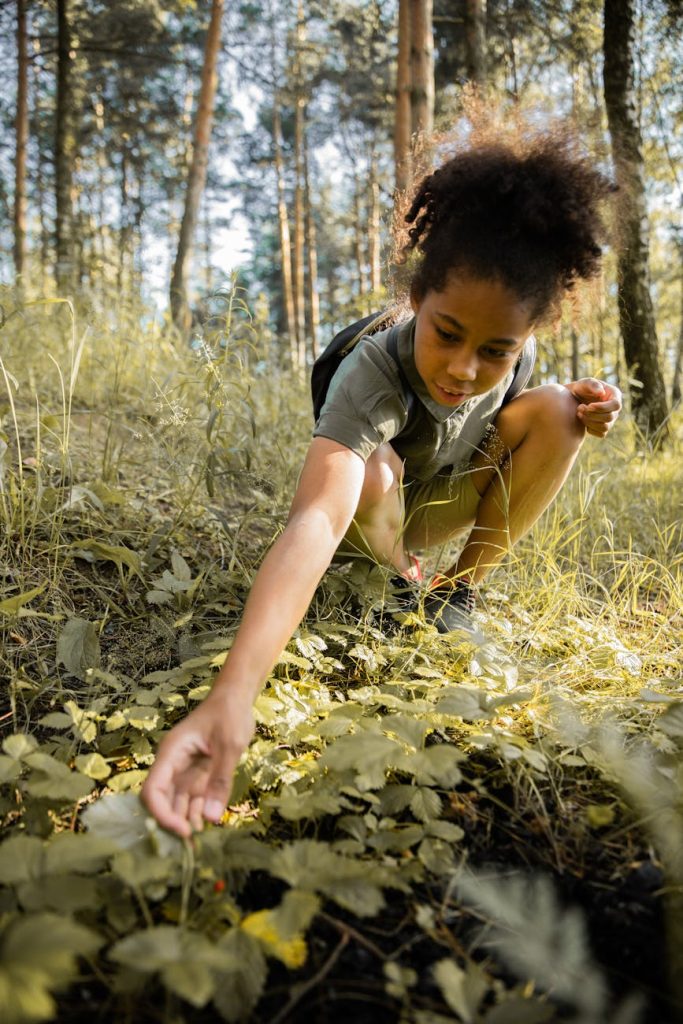Shinrin-yoku, also called nature bathing or forest bathing, started in Japan in the 1980s. It’s accessible, free, and a highly effective ADHD self-regulation tool for your daughter. It doesn’t require a bathing suit—and it’s just outside. So what is it, exactly?
Imagine:
You’ve discovered a hidden path dappled with sunlight under a canopy of trees. Walking along the trail, you hear the sound of rustling leaves and the gentle burbling of a nearby creek. You pause and inhale as the sweet, woodsy scent of sap surrounds you like a cozy blanket. You feel the lush grass tickle your ankles when you wiggle your bare toes into the warm earth. As time passes, your mind slows down, and you breathe deeper. Your jaw unclenches, your shoulders relax—and the natural power of this ADHD self-regulation tool begins to take hold. You drink in the world around you and be just as you are.
That’s nature bathing. Not rushing, not thinking, not doing. Just being in nature, in a calm, peaceful space. It works wonders for self-regulation and mood, especially with ADHD kids. And here’s the cool thing, you don’t have to drive to a lake or find a remote hiking trail. Your backyard has all the nature your daughter needs.
Nature Versus Noise
All humans, including your daughter, have an innate connection to the natural world. But every day, she gets farther away from nature as technology advances and the world gets more high-tech. She’s living in a highly demanding environment where communication happens at lightning speed. Constant alerts, noises, and digital distractions zap your daughter’s focus and peace of mind. It’s just a byproduct of the world she lives in.
On the other hand, natural, green environments calm the nervous system and reduce stress. And it doesn’t take much. A study published in the Journal of Attention Disorders found that ADHD kids had significantly better concentration after a 20-minute walk in nature versus the same walk in an urban area.

Benefits of Natural Environments
“I’m just so much more conscious of the power of nature to help us take a deep breath and regroup. I joke that my dog has added an extra decade to my life because he gets me outside multiple times a day. I’m getting exercise and exposure to nature.
~~ Kathleen Nadeau, internationally recognized ADHD authority, Founder and director of the Chesapeake ADHD Center
Mental Benefits of Forest Bathing
Spending time in a natural environment allows your daughter’s mind to rest. Nature doesn’t demand her attention; there are no tasks to start or goals to achieve. Without that pressure, her mind can naturally explore the space she’s in, improving her ability to pay attention and focus. And that makes sense—nature acts as an ADHD self-regulation tool by giving her brain a break from overuse and stress when no demands are on her attention. In other words, she gets back to her day refreshed and restored.
Mood Benefits
On its own, green time improves your daughter’s mental health and well-being. It’s that innate connection to nature at work. Also, negative ions in the air, organic sights, sounds, and smells all work together to reduce anxiety and depression. Outside time also naturally reduces the stress hormone cortisol while improving vitamin D production. A study in 2019 showed decreased tension, anxiety, anger, and fatigue in kids after two forest bathing experiences.
Physical Benefits
Green time not only improves her mental and emotional health, it improves her physical health, too. Increased time outdoors and exposure to natural sunshine help regulate circadian rhythms or the sleep-wake cycle. Hello, better sleep! Time in nature also boosts your daughter’s immune system and improves her digestive health.
Nature Provides Gentle Sensory Support

For your daughter, daily life can be an overwhelming barrage of sensory input. Bright lights, overlapping noises, itchy socks—everything feels dialed up to 11. But nature creates grounding sensations, not grating ones. It’s a gentle ADHD self-regulation tool that soothes rather than overwhelms.
Think:
-
Trailing her fingers across the rough bark of a tree
-
Inhaling the scent of dewy grass or wildflowers
-
The fresh air and warm sun on her face
-
The sound of leaves crunching underfoot
In other words, nature is a welcome escape from the incessant hum of an A/C, harsh fluorescent lights, or whatever it is that’s short-circuiting her senses. Instead of overstimulating canned noise, this soothing sensory input helps your daughter decompress and reconnect with herself.
Nature Bathing Encourages Movement
While nature bathing isn’t the same as exercise, the two are connected. Being outside naturally encourages movement. For instance, skipping rocks across a pond, climbing a low tree branch, or twirling in the grass. It feels good, and it’s spontaneous, joyful, and valuable. Nature bathing on its own is a powerful ADHD self-regulation tool, but when combined with gentle movement, it’s the secret sauce to emotional regulation, focus, and resilience.
You can easily introduce forest bathing into your daughter’s daily routine. A few minutes in the backyard can do the trick. Two ADHD researchers from Illinois University discovered nature’s benefits don’t diminish when the space is familiar, like a city park or trees in your backyard. All it takes is intention and presence. In fact, nature is so powerful that even houseplants help improve symptoms of ADHD.
No Backyard? No Problem
Research showed that children living in urban areas with a daily view of greenery (like a tree outside the window) had less severe ADHD symptoms than kids with no exposure to nature. Open windows if you can, and share photos of nature with your daughter. Ask her to imagine what it feels like. What would she smell? Feel? One reason nature therapy is so effective is the break from directed attention. Your daughter naturally directs her attention to soothing, organic stimuli.

5 ADHD-Friendly Ways to Incorporate Forest Bathing in Your Daughter’s Life
- Set a timer for 20 minutes and get outside. It doesn’t matter where—your backyard, the city park, or even a local cemetery! Make sure to leave all phones and gadgets inside to fully enjoy nature. In other words, no agenda, no pressure, just some good old-fashioned time outdoors.
- Encourage her to fully immerse herself in the experience. Try asking her questions that involve her senses. Can she find 3 things that feel different to the touch? What sounds does she hear?
- Start a discussion and nature journal about how she felt outside. Focus on senses and feelings more than facts. For example, I felt calm when I watched the clouds drift by instead of “I saw clouds.”
- Build it into daily transitions. Even 5 minutes of outside time after lunch or before homework helps.
- Let her get dirty. Seriously. Mud pie-making, rocks in her pockets, grass-stains on her jeans dirty. It’s good for her and helps her connect to something bigger than herself.
As an added bonus, check out your favorite podcast station or Youtube station and search for terms like “guided nature walk” or “forest meditation for kids.” Many of these recordings are free, and listening to them helps with intentionality and presence.
Reconnect With Nature
The bottom line is that nature helps kids thrive, especially kids with ADHD. Your daughter might not find peace at school. The grocery store might overwhelm her. But when she’s outside, she can be herself—at peace. Nature is an ADHD self-regulation tool that doesn’t judge her or tell her to be quieter or neater. It’s just an inviting space to be. And sometimes, that’s exactly what your daughter needs. No fixes, no hacks, just a peaceful place to be.
About the Author

Alex Alcon
Alex Alcon, RN, Freelance nurse content and copywriter, owner of RN2Pen LLC.

Cynthia Hammer, MSW
Cynthia Hammer, MSW, is an ADHD advocate helping girls get timely diagnoses. She's the founder of FINDtheADHDgirls, Executive Director of Inattentive ADHD Coalition, and author of Living with Inattentive ADHD.
Share via:

